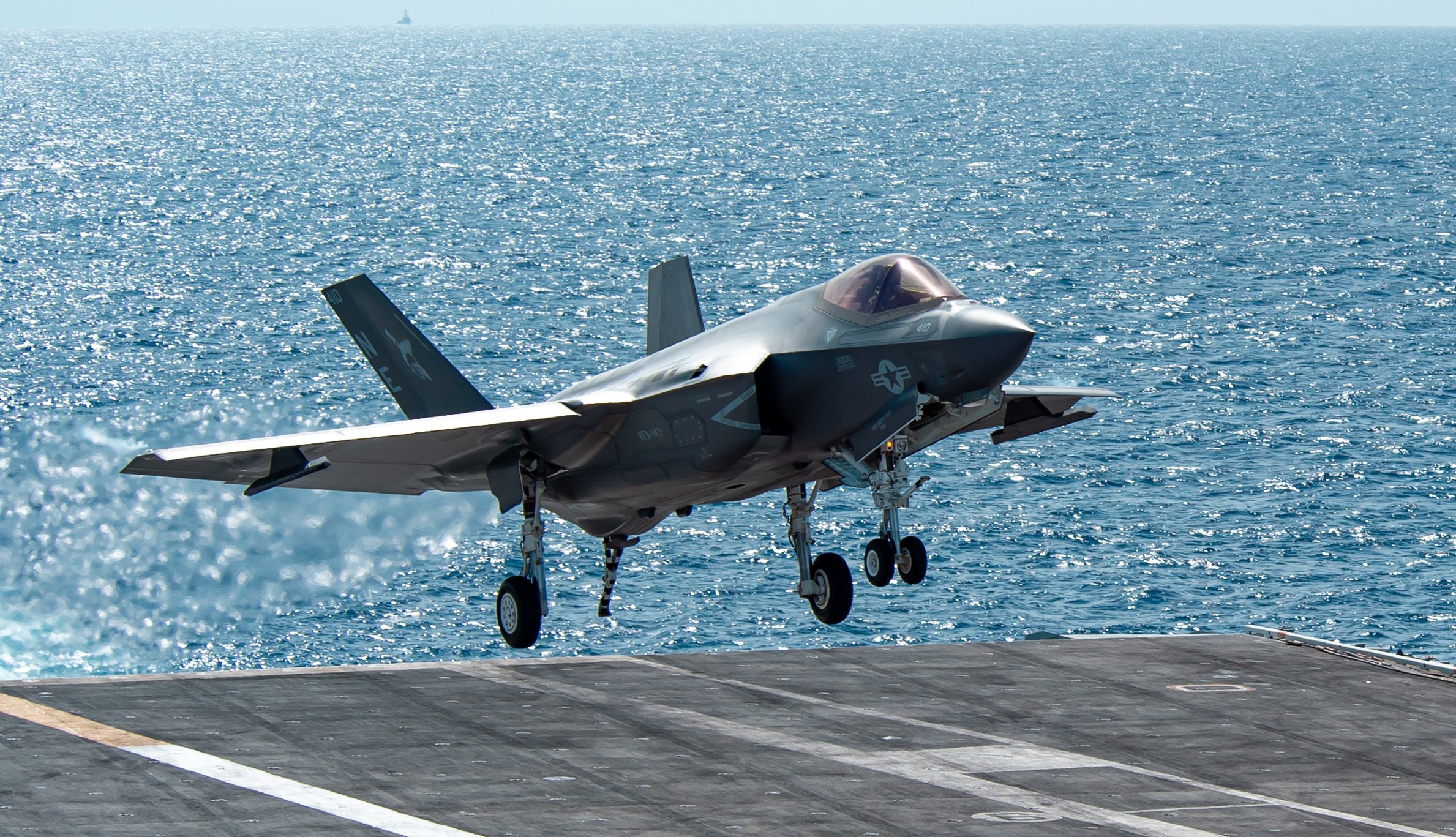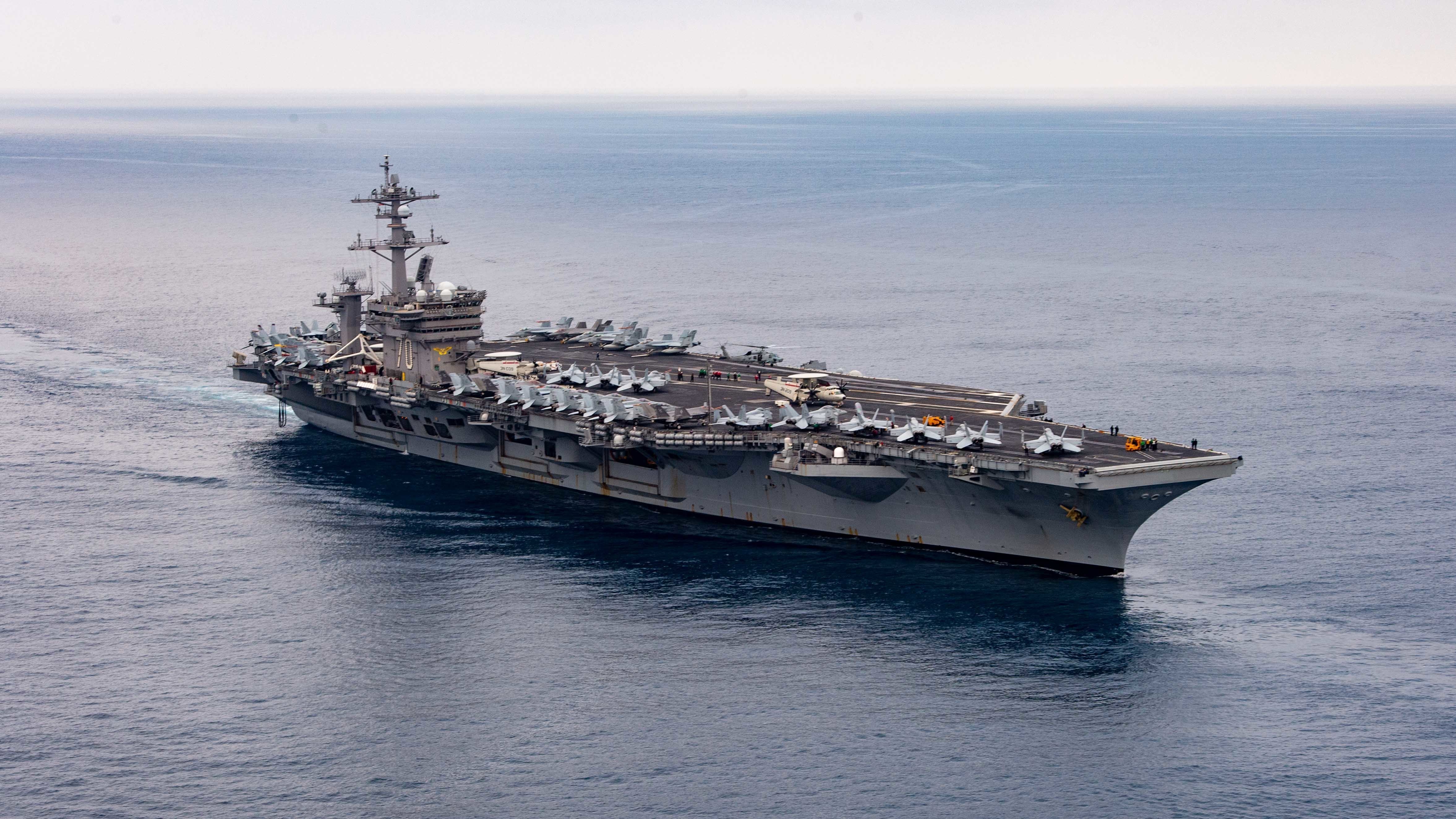
An F-35C Lightning II, assigned to the “Argonauts” of Strike Fighter Squadron (VFA) 147, prepares to land on the flight deck of Nimitz-class aircraft carrier USS Carl Vinson (CVN 70) June 17, 2021. US Navy Photo
The Nimitz-class aircraft carrier USS Carl Vinson (CVN-70) departed San Diego Bay Monday afternoon with nearly 6,000 sailors and a crowded flight deck to begin a scheduled deployment to the Indo-Pacific region, marking a key milestone for 21st-century naval aviation.
Aboard Vinson is Carrier Air Wing 2, the Navy’s first fully integrated air wing to deploy overseas with both the F-35C Lightning II fifth-generation, multi-mission strike fighter and the new CMV-22B Osprey tiltrotor.
The single-seat F-35C jets, assigned to Strike Fighter Squadron 147 based at Naval Air Station Lemoore, Calif., are the newest jet to expand the wing’s capabilities to project air power at sea. The CMV-22B, flown by the “Titans” of Fleet Logistics Multi-Mission Squadron 30, will extend the air wing’s legs, expanding the logistical resupply reach for the carrier and strike group.
The Osprey, with its short takeoff and landing capabilities, provides Vinson and Carrier Strike Group 1 with the carrier-on-board or COD mission that has long been provided by the Navy’s aging C-2 Greyhound turboprop airplane.
The presence of the Osprey in the carrier air wing as the COD aircraft also exponentially expands the resupply distance and time. A carrier-version of the Marine Corps’ MV-22B Osprey, the CMV-22B, can take off and land like a helicopter but fly like an airplane at higher altitudes, with faster speed and at longer range. It can haul needed spare parts, including the F-35C’s replacement F135 jet engine, if needed, from either a cargo ship at sea or a shoreside facility, as Vinson practiced back in March with the CMV-22B.

Nimitz-class aircraft carrier USS Carl Vinson (CVN 70) transits the Pacific Ocean, July 11, 2021. Vinson is currently underway conducting routine maritime operations in U.S. 3rd Fleet. US Navy Photo
Officials haven’t detailed where the carrier strike group will deploy other than to the Indo-Pacific region to support global maritime security operations. “It’s all dependent on where we’re needed in the world,” Vinson‘s spokeswoman, Lt. Cmdr. Miranda Williams, said in a San Diego Fox5 news segment Monday morning.
Vinson left its pier at Naval Air Station North Island in Coronado, Calif., and headed out to sea to join other ships in the strike group based in San Diego or Hawaii for the deployment. They include guided-missile cruiser USS Lake Champlain (CG-57) and a half-dozen guided-missile destroyers: USS Higgins (DDG-76), USS O’Kane (DDG-77), USS Chafee (DDG-90), USS Dewey (DDG-105), USS Stockdale (DDG-106) and USS Michael Murphy (DDG-112).
Aboard Vinson are more than five dozen aircraft assigned to CAW-2.
Along with the “Argonauts” of VFA-147, the air wing includes the “Bounty Hunters” of VFA-2, which fly the F/A-18F Super Hornet; the “Stingers” of VFA-113 and “Golden Dragons” of VFA-192, both of which fly the F/A-18E Super Hornet; the “Gauntlets” of Electronic Attack Squadron 136, which fly the F/A-18G Growler; the “Black Eagles” of Carrier Airborne Early Warning Squadron 113, which fly the E-2D Hawkeye; the “Blue Hawks” of Helicopter Maritime Strike Squadron 78, which fly the MH-60R Seahawk; the “Black Knights” of Helicopter Sea Combat Squadron 4 flying the MH-60S Seahawk; and the “Titans” of Fleet Logistics Multi-Mission Squadron 30 flying the Osprey, according to U.S. 3rd Fleet.
Vinson returned to San Diego in September 2020 in a homeport shift following a 17-month overhaul in at the Puget Sound Naval Shipyard & Intermediate Maintenance Facility in Bremerton, Wash., where the ship went through a scheduled $367 million dry-docking and overhaul and upgrades throughout the carrier to include modernization to accommodate the F-35C.
